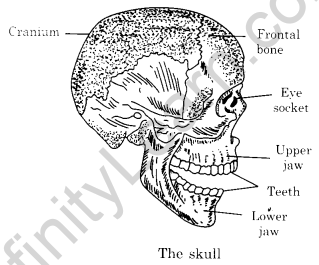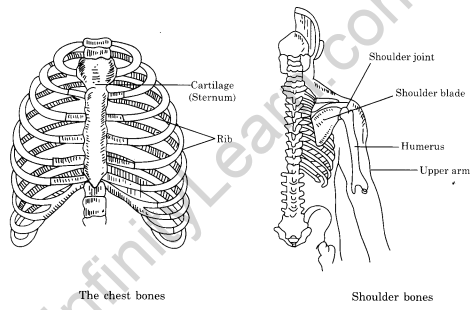Table of Contents
CBSE Class 6 Chapter 8 Science Notes Body Movements
Body Movements Class 6 Chapter 8 Science Notes: According to the CBSE Syllabus for the academic year 2023-24, the chapter 8 is labeled as Body Movements. The study of body movements is a fundamental aspect of understanding the mechanics and dynamics of the human body. In this chapter, “Introduction to Body Movements,” we delve into the intricate ways our body functions in motion. From the subtle adjustments of joints to the coordinated efforts of muscles, this exploration provides a foundational understanding of how our body moves and adapts to various activities. By examining the principles of body movements, we lay the groundwork for comprehending the broader concepts of anatomy and physiology, essential for anyone eager to grasp the complexities of the human form.
Chapter 8 Revision Notes Download Essential Topics PDF
- Concept of Body Movements
- The Skeletal System
- The Axial Skeleton
- The Appendicular Skeleton
- The Joints and Its Types
- Functional Joints and its Types
- Structural Joints and its Types
- Gait of an Earthworm
- Gait of a Snail
- Gait of a Cockroach
- Gait of a Fish
- Gait of a Bird
Skeletal System
- Bones in our body form the framework that supports the whole body. This framework is called the skeleton.
- Our skeleton is made up of a number of bones and cartilages.
- There are about 650 muscles attached to the various bones in our body.
- The bones are hard and rigid.
- Cartilages are comparatively soft and elastic.
Functions of skeleton
- Skeleton system gives support to the body.
- It protects the inner organs.
- Together with muscles, it gives the body its shape.
- Red blood cells and some white blood cells are produced in the marrow of the bone.
X-ray machine: We can get photographs of bones by a machine called X-ray machine. Doctors use these photographs to examine the injuries and diseases of bones.
The bones in our body vary in their sizes and shapes. Different types of c bones have different functions.
The skull: The skull has two main parts:
- Cranium: The bones of cranium are flat. They are held firmly like a zipper. It covers and protects the brain.
- Facial bones: The facial bones comprise the upper jaw, lower jaw and few other bones. The lower jaw is movable. The movement of lower jaw enables us to eat, talk and sing.

Eye sockets: The skull also includes a pair of eye sockets. These form a safe pocket for eyes.
The backbone: Backbone or vertebral column is composed of 33 small, ring like vertebrae joined end to end. It forms a hollow bony tube. The main nerve cord passes through it.

The Chest bones: 12 pairs of ribs along with backbone make a cone-shaped cage, called rib-cage, which protects the heart.

The Shoulder bones: The shoulder bone is formed by the collor bone and the shoulder blade. The shoulder bones are flat and large. They help in forming joints with long bones.
Hip bones: The hip bone is formed by the fusion of three bones. Like shoulder bones, the hip bones are also flat and large. They help in forming joints with long bones. Together with the last two parts of backbone, it forms a large bony bowl called pelvis.

Bones of hands and legs: Bones of arms, thighs, etc., are long. They give strength to our body. Bones of fingers and toes are short. They help us in holding things. The hands and legs are constructed in same pattern as described below: (See Figs).
| Part of hand | Part of leg | Number of Bones |
| Upper arm | Thigh | One long bone |
| Fore arm | Lower leg | Two long bones |
| Wrist | Ankle | Several small bones |
| Palm | Foot | Five bones |
| Fingers | Toe | Each has three small bones (except thumb, which has two small leaves) |
Bone joints: The place where two or more bones meet together is called a joint. In our body, five types of joints are present namely:
- Fixed joints which do not allow movement, e.g., joints of cranium.
- Ball and socket joint allow movement in all directions, e.g., joints between upper arm and shoulder, thigh and hip.
- Pivotal joint allows movement in many planes, e.g., skull makes such joint with first two vertebrae.
- Hinge joints allow movement only in one direction, e.g., fingers, the knee, etc.
- Gliding joints allow only a limited amount of movement, e.g., joints of backbone.

Muscles: The bones are moved by the alternate contractions and relaxations of two sets of muscles.
Tendons: join muscles to the bones.
Ligament: joins two bones.
Bristles: Bristles are hair like structure, connected with muscles. The bristles help to get a good grip on the ground. ‘
Cavity: It is the hollow space or cavity in one bone, into which the other bone fits. Such joint allows movements in all directions.
Gait of animals: Some animals do not have bones. They have muscles which help to extend and shorten the body. During movement, animal first extends the front part of the body, keeping the rear position fixed to the ground. After that animal fixes the front end and releases the rear end. Now animal shortens the body and pulls the rear end forward. During this practice, animal moves forward by a small distance.
Rib cage: Ribs join with the chest bone and the backbone together to form a box. This is called rib cage.
Locomotion
There are two kinds of movements:
- The organisms move their body parts without changing their position.
- Animals move from one place to another. This kind of movement is called locomotion.
Locomotion in some Animals
- Birds: Most of the birds have two kinds of locomotion. They walk with legs on the ground. They also fly in the air. Ducks and swans also swim in water.
- Flying adaptations: Streamlined body, bones with air spaces, forelimbs modified into wings, air sacs connected to lungs and massive flight muscles are some adaptations in birds for flying.
- Fish: The fish swims by forming loops alternately on the two sides of the body. The tail pushes them forward. The vertebrae and the muscles attached to them work for it.
- Snakes: Similarly, the snakes crawl on the ground by alternately looping sideways. A large number of vertebrae and associated muscles push the body forward. The ventral scales also help in the process.
- Insects: The body and legs of insects have hard joined coverings, forming an exoskeleton. The muscles of the breast connected with three pairs of legs and two pairs of wings help the cockroach to walk and fly.
- Snails: The snails are moved by the muscular foot. The hard unjoined shell have no relation with the foot.
- Earthworm: The earthworm moves by alternate extension and contraction of the body affected by the muscles. The minute movable bristles help in gripping the ground.
Backbone: Backbone or vertebral column is composed of 33 small ring like bones called vertebrae. It is a hollow bony tube.
Ball and socket joint: A joint in which rounded end of one bone fits into the cavity of the other bones.
Bristles: Hair like structures projecting out of the body of earthworms. With the help of these, it fixes itself with the ground.
Cartilage: It is the additional part of the skeleton that is not as hard as the bones and which can be bent also.
Cavity: The bowl like part (hollow space) in the shoulder bone allows the rounded end of the arm bone to fit into it to form ball and socket joint.
Fixed joints: Some of the joints allow no movement. These are called fixed joints, e.g., joints in skull and upper jaw.
Gait of animals: Some animals do not have bones. They have muscles which help to extend and shorten the body. During movement, animal first extends the front part of the body, keeping the rear position fixed to the ground. After that animal fixes the front end and releases the rear end. Now animal shortens the body and pulls the rear end forward. During this practice animal moves forward by a small distance.
Hinge joint: Hinge joint is found in the fingers, elbow and knee. It allows movement only in one direction.
Muscle: Muscles are involved in the movement of bones.
Outer Skeleton: Skeleton found outside the body is called outer skeleton, e.g., hair and nails in human.
Pelvic bones: Bones in the hip region are called pelvic bones.
Pivotal joint: The joint where our neck joins the head is a pivotal joint.
Rib cage: Ribs join the chest bone and the backbone together to form a box. This is called rib cage.
Shoulder bones: The two bones of the shoulders are called shoulder bones.
Skeleton: The framework of the body which is made up of bones and cartilage is called skeleton.
Streamlined: The body shape where body tapers at both ends is called streamlined body, e.g., body of birds and fish.
We hope the given CBSE Class 6 Science Notes Chapter 8 Body Movements Pdf free download will help you. If you have any query regarding NCERT Class 6 Science Notes Chapter 8 Body Movements, drop a comment below and we will get back to you at the earliest.






